There are a number of benefits to carrying out a programme of preventive maintenance. In this article we share a complete guide to those benefits and why maintenance engineering businesses use Preventive Maintenance Software to manage their job schedules.
What is Preventive Maintenance?
Preventive Maintenance is the act of carrying out inspections and maintenance on assets before an unexpected failure occurs. Or put another way, fixing it before it breaks.
Downtime for assets is costly and unexpected equipment failure can leave a business unable to operate, limit revenue generation and in some cases be harmful to those who use the machinery. Maintenance engineering businesses who carry out repairs and services on mechanical and electrical assets use Preventive Maintenance to extend the lifecycle of an asset and ensure their client can continue to run the equipment.
Types of Preventive Maintenance
There are several different types of Preventive Maintenance philosophies you can follow, these vary based on the type of equipment you are servicing.
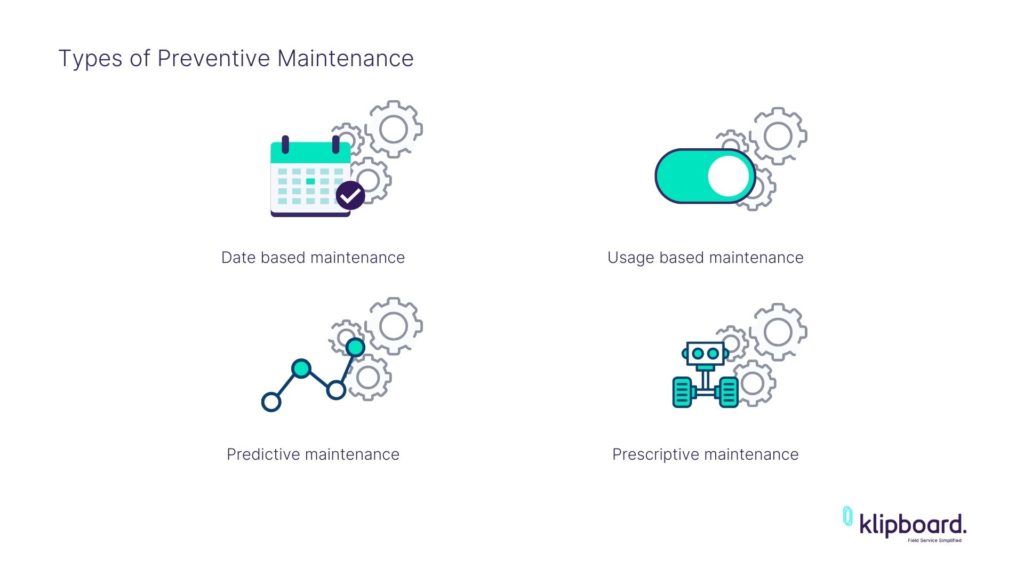
Data based Maintenance
This is a programme of inspections and maintenance based on a predetermined frequency. Commonly this is set to daily, monthly, annually.
Often for compliance focused equipment such as Healthcare or Medical Devices, HVAC, Water Treatment or Fire Safety assets, the frequency is determined by the standards or codes in place that the asset operator or owner has to adhere to.
Usage based Maintenance
In the instance when compliance is the determining factor for the frequency of servicing, then maintenance businesses may opt for usage based. Mechanical or Electrical equipment, especially those with moving parts that will require replacement will benefit from this type of preventive maintenance.
Assets used daily and are put under significant strain will greatly benefit from usage based maintenance schedules.
Predictive Maintenance
Assets or equipment that use sensors, condition monitoring tools or performance monitoring software will commonly be placed on a predictive maintenance schedule.
This is a smart way of working as it reduces the probability of downtime. The monitoring equipment identifies an issue before the engineer is even aware of the potential fault. Vibration sensors and Motor Current Signature Analysis (MCSA) can be used to spot small changes in performance without interrupting the operational performance of the asset.
The Internet of Things (IoT) is opening the door to more of this technology to be introduced into commonly used equipment.
To read more on this check out our article: Will smart machines replace field service workers?
Prescriptive Maintenance
Prescriptive Maintenance is an algorithm that can be created to adjust an asset’s maintenance schedule based on machine learning. This is similar to the smart tech used in Predictive Maintenance only rather than sensors simply monitoring and looking for signals, Prescriptive Maintenance can adjust the programme according to the real time performance on the asset.
Cost of Preventive vs Reactive over time
The cost implications for Preventive, Predictive and Reactive maintenance differs over time. Working on a purely reactive maintenance strategy will, at least initially be very cost effective. It’s unlikely assets will fail within their initial usage, however as time goes on the likelihood and frequency of repairs will increase and so will the costs.
Preventive Maintenance will initially be costly. Inspections and maintenance will be carried out on assets and equipment which should, at least initially be running at an optimum performance level. Again over a period of time that story changes the benefits of Preventive Maintenance begin to pay off as the need for frequent repairs has reduced and the overall life cycle increased.
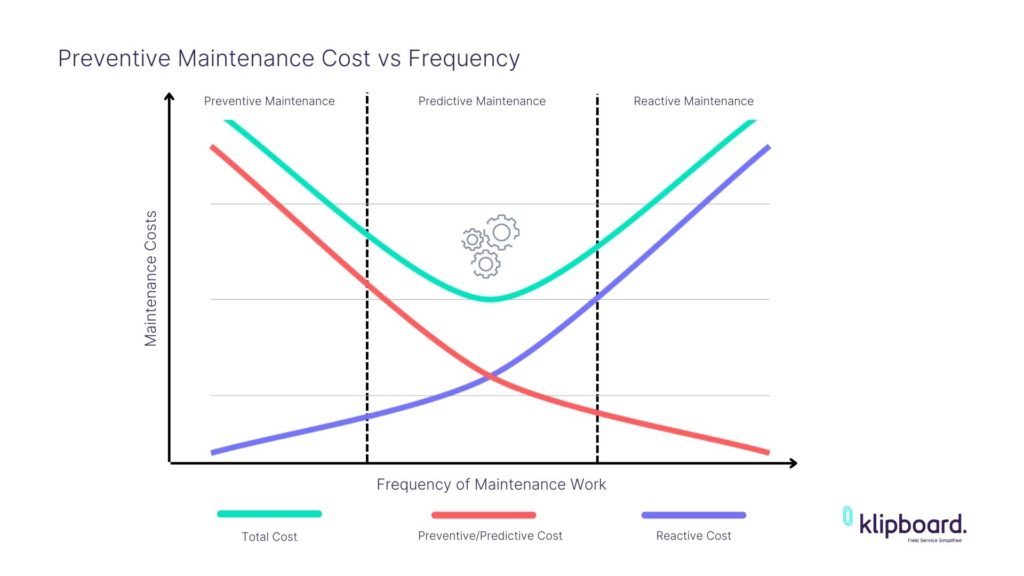
The ideal maintenance frequency exists somewhere in the middle where you can agree minimum interaction at first as the assets are new and slowly move into a sustained and frequent period of Preventive Maintenance. Preventive Maintenance Software can help you plan in the dates for these services and provide insight into failure rates and frequency of repairs to help you decide when to increase frequency.
What is Preventive Maintenance Software?
Preventive Maintenance Software allows Maintenance and Servicing businesses to organize their workload and manage the lifecycle of their clients more effectively.
It introduces improved visibility of team availability, better schedule planning, service date tracking, insights and finance performance metrics to a business.
The software varies by supplier, the type of features offered and the size of business using the software. It ranges from fully featured EAM/CMMS software to more basic Job Planning Software. The more complex versions of Preventive Maintenance Software will include a richer suite of features for managing a CRM system, building and maintaining an Asset Register, inventory management and reporting functions.
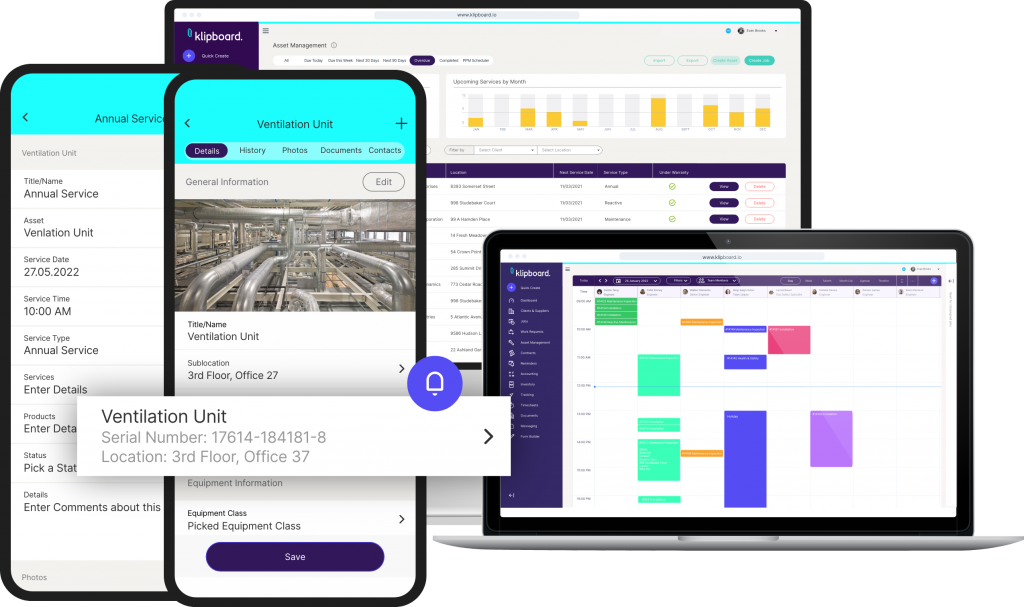
Why use Preventive Maintenance Software?
There are plenty of benefits to using Preventive Maintenance Software, here a few examples of what it’s used for:
Scheduling services
- Keeping on top of service dates
- Optimizing Field Team work schedules
- Avoiding double bookings
- Ensuring more jobs can be completed
Reducing Downtime
- Identify potential failures early
- Ensure longer asset life cycle
- Reduces capital expenditure
- Maintain productivity
Cost control
- Reduce call out fees
- Use fewer parts or spares
- Avoid expediting purchase costs for parts
- Track life cycle costs
Meeting Compliance
- Standardize data collection
- Improved ability to report and audit
- Track safety incidents
- Store and Manage Permits, Licenses and Engineer notes
Operational Efficiency
- Reduce admin duplication
- Speed up invoicing times
- Single source of information
- Limits the potential for human error
What features do you need from your Preventive Maintenance Software?
Job Scheduling and Dispatch Board
Intelligent scheduling tools can significantly improve how effective your team is in completing your client’s jobs. Preventive Maintenance Software that includes this allows your team to operate with more flexibility, it helps ensure all team members are informed of where everyone needs to be and allows you to build in space into your preventive maintenance schedule for when a reactive job or emergency call out is requested.
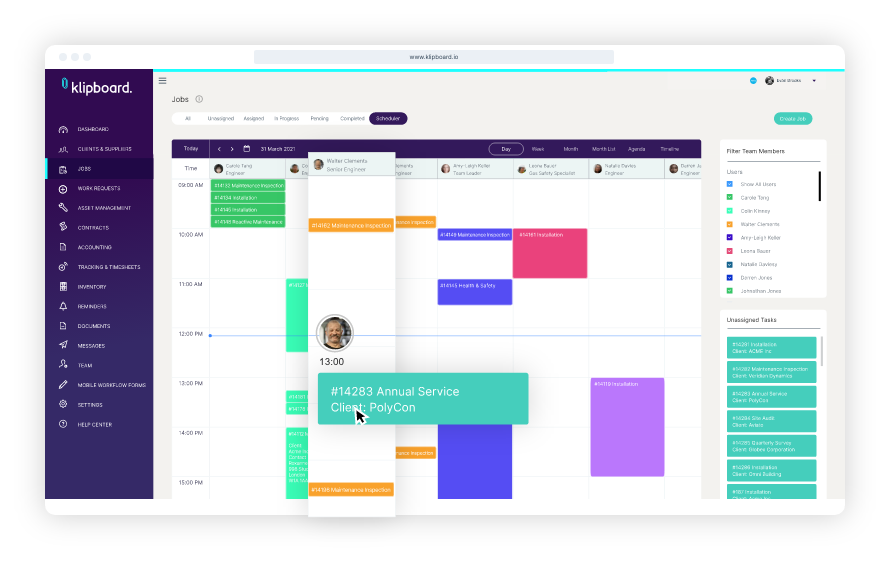
Drag and Drop schedulers have been a game changer for Field Service businesses. They allow you to create a job, or pick a scheduled job and assign that to a team member who is an ideal fit for the work. This could be based on their current geographical location or if they have certain skills or credentials.
PPM & Asset Management
The most important feature to have in your Preventive Maintenance Software will be your Asset Management or Planned Preventative Maintenance (PPM) tools. This allows you to gain insight into your customers assets, their required service dates and access their service history.
In today’s fast paced world with demanding customers you need to be able to quickly access what you need, either in the office or in the field. Asset Management tools give you a single location for everything you need. It give you a clear overview of all your client’s assets and includes details such as Asset Service Due dates and a list of upcoming services.
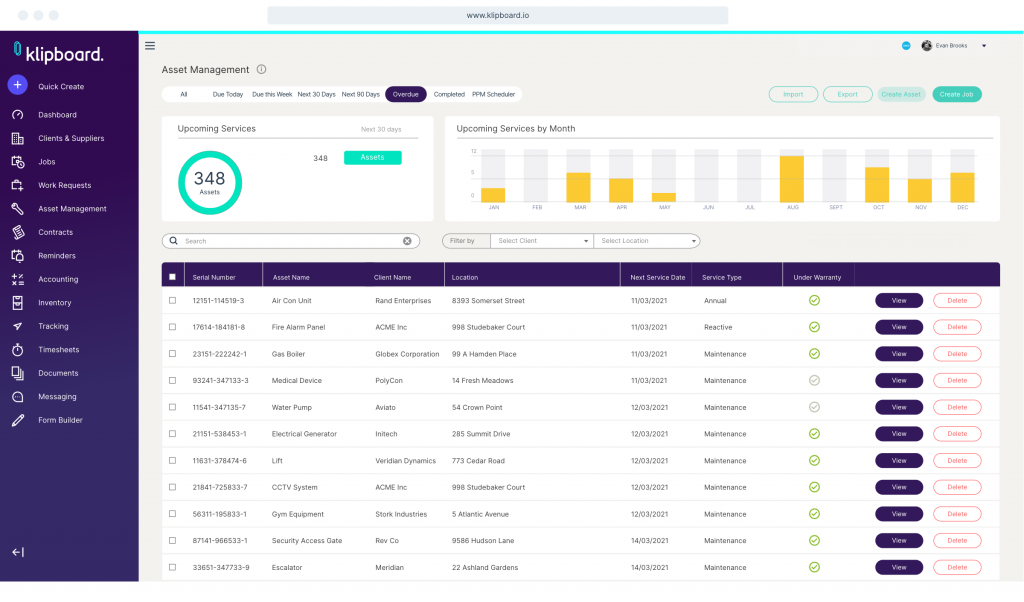
Preventive Maintenance Software allows you to set up a PPM schedule for a client’s asset. Once the recurring job is created based on the frequency options you decide, such as daily, weekly, monthly, annually, your software will let you know when the service is due.
Instant access to service history will mean your team in the field can use their smartphone or tablet to gain insight and make smarter decisions. Once the job details are synced with their mobile device they can even access this information in locations with poor or no signal.
Digital Mobile Forms
It’s time to stop using paperwork and triplicate forms. Lost paperwork, duplicated admin work and human errors are costing your business hours every week.
The average Field Service professional spends around 6 hours a week on their admin. That’s simply too much if you wish to carry out a schedule or preventive maintenance and keep the work of your engineers at a realistic and achievable level.
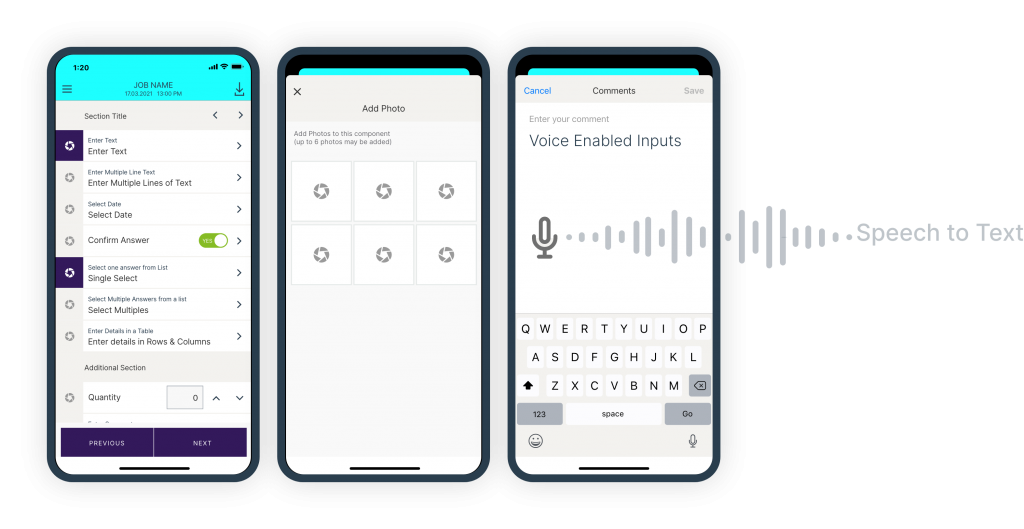
Digital Mobile Forms are a great way to collect inspection, repair and engineer notes from the field. They are easily built using Job Management Software and are accessible via their smartphone or tablet. This means you’re able to collect all the details of a job once then sync that data back to the office. No more lost paperwork, no inconsistent data collection and no more delays in invoicing for the completed work.
Automated Service Reminders
Servicing Businesses who use Automated Service Reminders can increase their recurring revenue by ensuring their customers are notified when one of their assets is due a service.
Your customers are most likely unaware of the service dates for their assets and will rely on you to inform them when the work needs to be carried out. However, you’ve got jobs to keep on top of and the day to day running of the business.
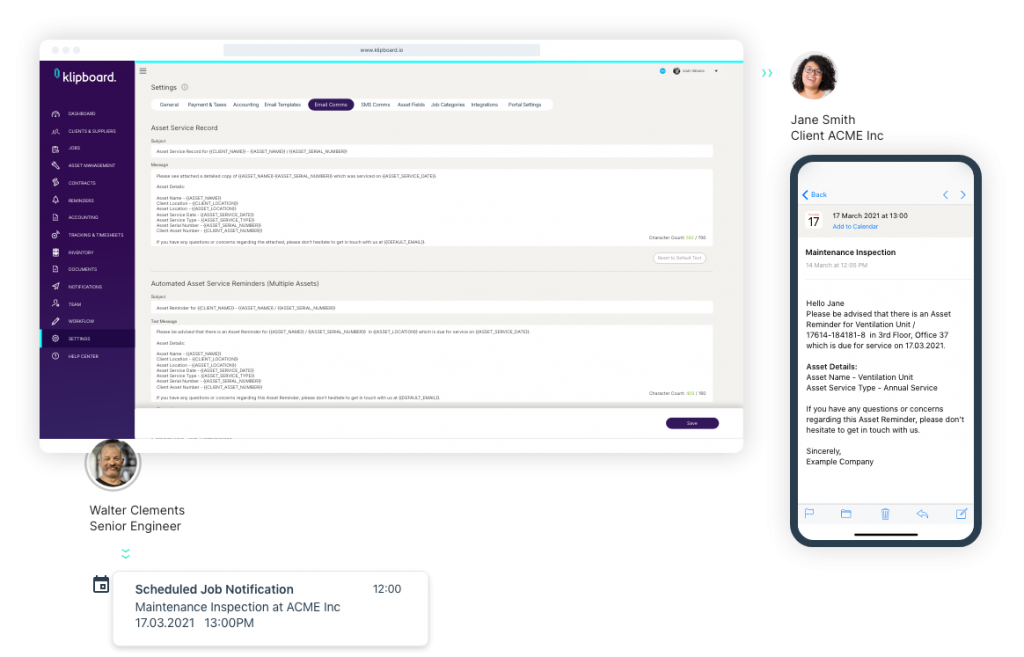
Being caught out with several due services at once can really impede your ability to complete all your scheduled work and can impact other customers should you need to urgently rearrange your schedule.
Use Automated Service Reminders to ensure you can complete more service jobs and reduce the amount of admin required.
Selling the benefits of Preventive Maintenance to your customers
You may have some customers who only use your services when their assets fail or break down. Bringing up the subject of introducing a programme of Preventive Maintenance would greatly benefit them.
Here’s how to sell the benefits of Preventive Maintenance to your customers.
Firstly, do they need it?
Start with considering the type of business they are and the assets that require servicing. It’s possible their asset portfolio doesn’t require periodic servicing. In most cases this is unlikely, especially if there are moving parts, mechanical or electrical equipment or equipment that requires certain compliance standards to be met.
Get clear on the benefits
Once you’ve established whether or not they operate the type of equipment that benefits from regular servicing, you’ll need to be clear on the benefits of a Preventive Maintenance Programme, these include:
- Reduced Asset Downtime
- Fewer Call out charges
- More predictable operational performance
- Consistent Revenue
Ultimately, the most impactful benefit felt by your customer is a consistent operational condition on their asset. This means their revenue isn’t affected and your preventive maintenance is considered more of an investment than a cost.
Use real world examples
If you specialize in a particular field such as HVAC units for example then you will have practical examples of how preventive maintenance can extend the life cycle of equipment. Especially if you have examples of customers who use this method vs others who don’t.
The proof is in the reporting
Once you have a customer set up on your Preventive Maintenance Programme use Job Management Software to set up PDR reports. These will show your customer exactly the work that was carried out and can include notes from your engineers. These notes are particularly useful should replacement of an asset be required, when supported by commentary from your engineer it helps your customer understand why it’s required.
Common mistakes when setting up Preventive Maintenance schedules
Much like assets themselves your Preventive Maintenance schedule will change over time. You’ll also need to make sure your team is properly trained to carry out the work.
- Failing to review if the schedule is fit for purpose
- Improper training for service technicians and field engineers
- Not fixing root causes for failure
Servicing businesses are caught out when they presume the current schedule can be maintained for a long time without review or adjusting the frequency of work. Another common mistake is continually replacing the same parts without establishing the root cause of failure.
Adjust your plan as you go. Set goals with your customer on the performance metrics of the equipment and make sure your team is confident to handle all of the types of assets you service.

Simplify Preventive Maintenance with Klipboard
Klipboard is an all-in-one Preventive Maintenance Software platform that’s perfect for helping you carry out Preventive Maintenance.
Using Klipboard will give you the visibility you need of your client’s assets and their service dates. It will provide a real time, always available source of insights and asset service information that your team needs.
Extend the life cycle of your customer’s assets and streamline your Field Service operation by using Klipboard for your Preventive Maintenance Programmes.
Book a 1 to 1 Demo of Klipboard with our team today: Click here

